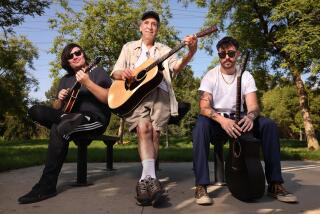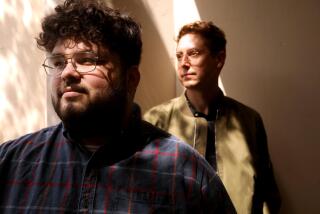Filling a Void : Big Brothers and Sisters Provide Friendship
- Share via
Cain McBrayer, Cathy Gallegos and Michael Evans are members of one of the nation’s most prominent youthful minority groups. They, along with an estimated 13 million other American children--a million of them in California--live in homes with only one parent. And in most of those homes that parent is the mother.
What such census statistics don’t show is the void left by the absent parent--the lack of male influence on a boy, the lack of the extra bit of friendship for a girl, the lack of an example of a harmonious marriage .
For these three Orange County children, however, a part of the emotional support that disappeared when their fathers died or moved elsewhere is being provided by volunteer men and women who have been matched with them through Big Brothers/Big Sisters of Orange County.
Perhaps the organization’s most traditional matchings involve men who are paired with boys without a father living at home. Since 1981, however, pairings also have been made between women and girls through the Big Sister program and, since 1980, between children of both sexes and married couples as part of a program called Couples for Kids.
For Bill Tornquist, his match with Cain McBrayer, 15, a Costa Mesa High School student, is what might be called a second-generation pairing. Tornquist, 25, a full-time caseworker for Big Brothers/Big Sisters of Orange County who is studying for a license in marriage and family counseling, was himself a “little brother” at age 10.
“My Big Brother is now my attorney,” he said. “And he was at my wedding. It was partly because of him that I decided to become a Big Brother myself. I remembered all the positive things that happened to me, and I wanted to do that for someone else.”
Being accepted as a Big Brother, said Tornquist, involved a screening process that included an orientation, an application, three character references, three psychological tests, two interviews and fingerprinting, all of which was reviewed by a screening committee.
When the screening is complete, the information gleaned in the testing is made available to the parent of the child, said Jo Alexander, the executive director of Big Brothers/Big Sisters of Orange County. The parent may then agree to the match or veto it, she said.
Controversy has arisen in recent years over the application of the screening process. In 1982, Big Brothers/Big Sisters of Orange County settled for an undisclosed amount of money out of court with the family of a boy who was sexually molested by his assigned big brother five years before. And in 1984 another Orange County big brother was convicted of molesting his little brother. He later received a suspended sentence.
In both cases, Big Brothers/Big Sisters of Orange County defended the screening process, calling the incidents rare errors.
More recently, a suit was filed against Big Brothers of Greater Los Angeles last December by the American Civil Liberties Union on behalf of a bisexual man who claimed he had been systematically excluded for consideration as a big brother because of his sexual preferences.
While the Big Brothers organization lists a national policy of nondiscrimination, “individual agencies have the right to set up their own policies,” said Alexander, and the policy of the Los Angeles agency bars homosexuals and bisexuals, she added.
In Orange County, however, the national policy is followed, she said. “I know of two homosexual men who came through the program here,” she said, “and one wasn’t placed because he didn’t pass a part of the screening.”
The other man passed, she said, but was rejected by the boy’s parent.
As with all Big Brothers, Tornquist was asked to commit to one year with his little brother and spend an average of four to six hours a week with him.
Anyone who is at least 20 years old, has lived in Orange County for at least six months, has worked at least three months at his or her current job and has valid auto insurance is eligible to become a Big Brother or Big Sister.
Tests also are given to the children to determine their needs and interests, said Tornquist. Based on the compatibility of those interests, as well as geography, the matches are made. “It helps if you don’t live too far away from each other,” he said.
McBrayer, who was 3 when his father died, had just turned 10 when his mother asked if he would be interested in the program.
“At first I was a little nervous,” he said, “but my nerves went away when Bill started coming over. It was great to do things with him. If I didn’t have him, I never would have gone to some of the places he took me to. He helped me feel more positive about myself.”
Tornquist said the relationship is less like father and son than two friends.
“I try to make him feel like we’re equals,” he said. “I may be older, but we’re really peers. We’re buddies. Over the last six years he’s become a best friend.”
The time the two spend together often involves nothing more elaborate than washing or waxing a car. In fact, said Tornquist, it was such common activities that made his relationship with his own Big Brother memorable.
“My Big Brother taught me how to wax a car,” he said. “That taught me how to take pride in things, so today I really take a lot of pride in my own car.”
‘Taught Lots of Things’
McBrayer said: “I think it’s neat of him to take the time to show me things like how to fix my bike, how to put on a tire, how to put things together. He’s taught me lots of things like that.”
While the “official” age span for little brothers and sisters is 6 to 16, many relationships continue past that time, Tornquist said.
“I’m not going to quit seeing Cain just because he turns 16,” he said. “I want to be at his wedding some day, just like Cain was at mine.”
Tornquist, who is compiling a trivia book based on the cartoon cat Garfield, said McBrayer has given him many of the 35 stuffed Garfields that fill his home. And he remembers a birthday card.
“That card was something that really struck me,” he said. “He signed it ‘Love, Cain.’ Then later he said, ‘Is it OK to say that if we’re both boys?’ I told him, ‘Sure.’ That kind of thing makes it worthwhile to me. He’s really a good kid. I like to think I had something to do with that.”
124 on Waiting List
Other Orange County children--and potential Big Brothers and sisters--have not been as fortunate as McBrayer and Tornquist. The reason is a supply-and-demand disparity. Currently there are 124 boys waiting to be matched with Big Brothers. However, there are more women waiting to be Big Sisters than there are girls who want one.
Tornquist said the Big Sister program has not received the wide recognition the Big Brother program has enjoyed. Also, he added, while women tend to be more interested in volunteering than men, “a lot of the mothers feel threatened by the idea of another woman having an influence on their daughters.”
One big-little sister relationship that has succeeded is the one between Sharon Barnett, 23, a counselor at Orangewood Children’s Home in Orange, and 10-year-old Cathy Gallegos of Placentia. Gallegos’ father died when she was 4, and her older brother and two older sisters also are matched with a Big Brother and Big Sisters.
In many cases, said Barnett, a mother seeks out a Big Sister for her daughter because a job or other family responsibilities keep her from spending enough time with her child.
However, she said, “in this case it’s something extra that’s there for Cathy. Her mother and I are really close, and we get along really well. There’s no strain. It’s really easy, like I’m just a friend of the family.”
Acting as a big sister, Barnett found, doesn’t mean becoming a pervasive influence on a girl.
‘A Slow Process’
“I guess my first impression was that I was going to be there for a kid who’s never seen the world, but she hasn’t needed that kind of support,” Barnett said. “You can’t say, ‘Wow, I’m going to change this child’s life completely.’ No, it’s a slow process to find the areas of need. But it’s that one extra phone call or extra hug or extra smile that makes it all worthwhile.”
Jim and Marian Lowerre would agree. With four natural children and three foster sons who are mentally retarded, the Orange couple, after 30 years of marriage, applied to the Couples for Kids program and were matched with then-10-year-old Michael Evans. Evans, who is now 15 and lives with his divorced mother, said he has found a second family with the Lowerres.
“My friend got into (the program) and I saw all the things they were doing, and I asked to get into it, too,” said Evans. “It’s like a dream. Jim’s like a father to me, and Marian’s kind of like my grandmother. They’ve shown me a lot of things and taught me stuff like politeness. I’ve done a lot of things I never would have done without them. We’ve had some rough spots, but we’ve had some pretty happy times, too. I get a lot of love from them.”
For their part, the Lowerres said Michael has become like a seventh child--or a grandson--to them.
“We’ve been together five years now,” Marian said. “We were one of the first couples in the program. And we had our own kids out from under foot, but we’d always had kids around, so we decided to apply.”
Couples Offer Model
The Couples for Kids program, said Beth Ennis, a representative of Big Brothers/Big Sisters of Orange County, is designed for children whose own parents may have a stormy relationship or have gone through a particularly traumatic divorce. Couples are screened in the same way as Big Brothers or Big Sisters, she said, but emphasis is placed on their ability to present a model of a happy marriage to the child.
There are fewer than a dozen couples active in the program in Orange County, she said.
“Jim and I are both children of divorced parents,” Marian Lowerre said. “So we want to show Michael a family environment and a successful marriage, or at least one that stays together.”
The couple “resolved that there wouldn’t be a broken home for our kids,” her husband said.
“Michael sees us fight, he sees friction, but we hope we’ve made a friend. We’ll stay with him.”
The couple’s influence has shown, Marian said, in “the positive effect on him, particularly in his scholastic improvement. He has the influence of our own kids to look at, and he can see the importance we put on education.”
Above all, she said, a couple involved in the Couples for Kids program must not flag in their commitment to the child.
“You have to do it as a couple,” she said. “You have to make your commitment and keep it. I have no patience with people who take a rejected child and reject him again. We’ve had a lot of joy with Michael. You can’t do everything for everybody, but if you put your energy into one thing, you can make a difference.”
More to Read
Sign up for Essential California
The most important California stories and recommendations in your inbox every morning.
You may occasionally receive promotional content from the Los Angeles Times.













